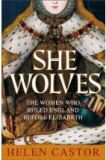 Helen Castor, She-Wolves: The Women Who Ruled England Before Elizabeth. Faber and Faber, London, 2010, ISBN 978-0-571-23705-0. RRP $45 (hardback)
Helen Castor, She-Wolves: The Women Who Ruled England Before Elizabeth. Faber and Faber, London, 2010, ISBN 978-0-571-23705-0. RRP $45 (hardback)
The book opens with the death of the young King Edward VI, seeming to bring to an end the promise of a glorious Tudor dynasty. There is no king to succeed him and for the first time in English history there is the prospect of a woman on the throne.
But which one? Mary, daughter of Catherine of Aragon, Anne Boleyn’s Elizabeth, or their cousins Mary, Queen of Scots and Lady Jane Grey.
Whoever is chosen, will she be as strong and as influential as four amazing women who “ruled” England at times between the 12th and15th centuries.
The author, a historian of medieval England and author of the Paston family biography Blood and Roses, gives a critical, sympathetic and well-researched look at Matilda, the only surviving legitimate child of Henry I; at Eleanor of Aquitaine, wife of Henry II; at Isabella of France, queen to Edward II; and Margaret d’Anjou, indomitable wife of Henry VI and implacable enemy of the Yorkists.
All four of them face the fact that men are always regarded as supreme rulers, but that confronting that premise and exhibiting ruthless determination, they can become powerful themselves, even if they become decried by history.
Matilda is far too often overlooked as the woman who nearly became queen but lost out to Stephen. Her relationship with her father, her marriage as a child to Heinrich V of Germany (later Holy Roman Emperor) gave her the ability in her supremely supportive role as his wife as queen and empress. After his early death she married Geoffroi of Anjou and became the mother of Henry II. The inscription on her grave at the French abbey where she lies reads: Great by birth, greater by marriage, greatest in her offspring, here lies the daughter, wife and mother of Henry.
Eleanor, ruler eventually in her own right as Duchess of Aquitaine, married Matilda’s son Henry and became Queen of England, giving him the sons that she had so notably failed to give her first husband, Louis VII of France. Her challenges and conflicts with her husband and her sons are the content of her passionate and political life.
Isabella, daughter of Philippe the Fair of France, was only 12 when she was sent to England to marry Edward II. The reign of this king is noted for his devotion to the wrong men as well as for his allegedly gruesome end. Isabella’s life, as his wife and mother of their four children, was a battle royal, earning her the title “She-Wolf of France”. Her power during her son’s minority, was ended in 1330 with her ambitious lover Roger Mortimer’s execution, but young Edward III let his mother live quietly until her death in 1358.
Margaret d’Anjou, yet another young princess sent across the Channel to marry an English king, is not just the vengeful queen of popular history. Arriving in a strange country she finds and gentle ineffectual husband and family whose quarrels escalate into warfare, threatening the king, herself and her son. Few can applaud her actions but her fierce fight for what she believes to be right is inevitable, even if it leads to another cross-Channel voyage to end her days.
These are the four who prove to the Tudor successors what can be done, and the final section reviews the reigns of misguided Mary, tragic Jane and Elizabeth, who finally showed that although “I have the body of a weak and feeble woman, I have the heart and stomach of a king – and a king of England too”. A She-Wolf indeed.
The writing throughout is a well-paced narrative that will keep you turning the pages almost as if it were a best-selling novel. But fiction this is not. It is extremely readable well-researched history that is blessedly uncluttered by notes and references at the bottom of each page. At the back of the book the author gives a summary of her sources as well as suggestions for further reading.
The insight into life and times of these women, the struggle to be regarded as more than just an item to be used as a bargain for peace or power, whose duty it would be to bed and bear heirs, is story that will enlighten and excite as their strength and skills, usually skimmed over in lesser histories, are revealed. And although many will regard them as monstrous manipulators, the opportunity to sympathise with their lives is given generously.
There are well-chosen illustrations and maps of England and France and well laid out and uncomplicated family trees are a bonus.
Well worth a place on your bookshelves, even if Ricardians will sigh at the only mention of Richard III regarding the fate of Edward V: the twelve-year-old heir to the throne … was deposed and murdered by Edward’s youngest brother and most trusted lieutenant, Richard, Duke of Gloucester…
This is, of course, a seemingly minor quibble. But, while we must respect everyone’s right to their own opinion, whatever happened to that the words alleged and allegedly? Safeguards for journalists and keepers of law and order, it can’t be too hard to admit there are other points of view.

Leave a reply